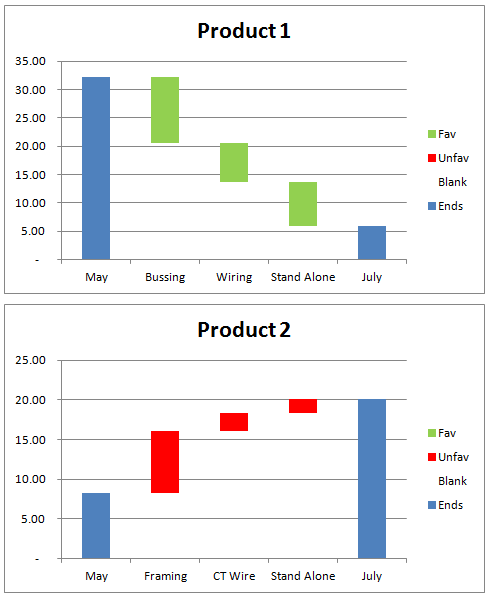Unlock a world of possibilities! Login now and discover the exclusive benefits awaiting you.
- Qlik Community
- :
- All Forums
- :
- QlikView App Dev
- :
- Waterfall Chart with Dimension
- Subscribe to RSS Feed
- Mark Topic as New
- Mark Topic as Read
- Float this Topic for Current User
- Bookmark
- Subscribe
- Mute
- Printer Friendly Page
- Mark as New
- Bookmark
- Subscribe
- Mute
- Subscribe to RSS Feed
- Permalink
- Report Inappropriate Content
Waterfall Chart with Dimension
Hi everybody!
I'm trying to figure a way to create a waterfall chart that shows hours/section and the dimension shows only the activities performed on that specific product line.
Below is my desired end result (created in Excel). As you can see, the values along the x-axis differ between the Product Line 1 and Product Line 2. I've looked at some other examples of waterfall charts here on QlikCommunity but they used data that was simpler and I can't figure out to translate the solution over to my data. My data has detail by person, by day, by job, which are specific to a particular product line.
I need to use a dimension because each Product Line will have different activities associated to it. For example, Product Line 1 has Bussing whereas Product Line 2 does not and Product 2 has Framing where Product 1 does not, etc.
The values on the x-axis would then change based on the selection in the Product Line list box.
I've attached a sample in Excel of how my data is structured (columns A through I on the "Data" worksheet).
Any help would be very much appreciated. I'd also like to note that I'm using the Personal Edition so I can't open any other QV workbooks ![]()
Thanks!
Justin

- Mark as New
- Bookmark
- Subscribe
- Mute
- Subscribe to RSS Feed
- Permalink
- Report Inappropriate Content
Each value should be an expressions, not a dimension. For the top chart in Product 1, you would have 5 expressions. You would need to use set analysis to determine the bar value, for example, May would be something like:
sum($<Month={'May'}> AMOUNT)
ETC, etc, for the others.
For bar 1, you wouldn't update the 'Bar Offset' inside of the expression, but for the other bars you would. For example, the Bar Offset for bar two would be the value of Bar 1:
sum($<Month={'May'}> AMOUNT)
and so on through all the bars.
Hope that helps!
- Mark as New
- Bookmark
- Subscribe
- Mute
- Subscribe to RSS Feed
- Permalink
- Report Inappropriate Content
I meant to call this out in the original post, but I need to use the dimension because each Product Line will have different activities associated to it. For example, Product Line 1 has Bussing whereas Product Line 2 does not and Product 2 has Framing where Product 1 does not, etc.
The values on the x-axis would then change based on the selection in the Product Line list box.
- Mark as New
- Bookmark
- Subscribe
- Mute
- Subscribe to RSS Feed
- Permalink
- Report Inappropriate Content
I have an excel example how it should look like: Month: November

I need a filter to choose the month. The first bar should be the last month, in this case it is October and the last bar should be the cumulated measure of the month. Between these two bars I need the changes in each position.
I hope I explained my issue clear enough.